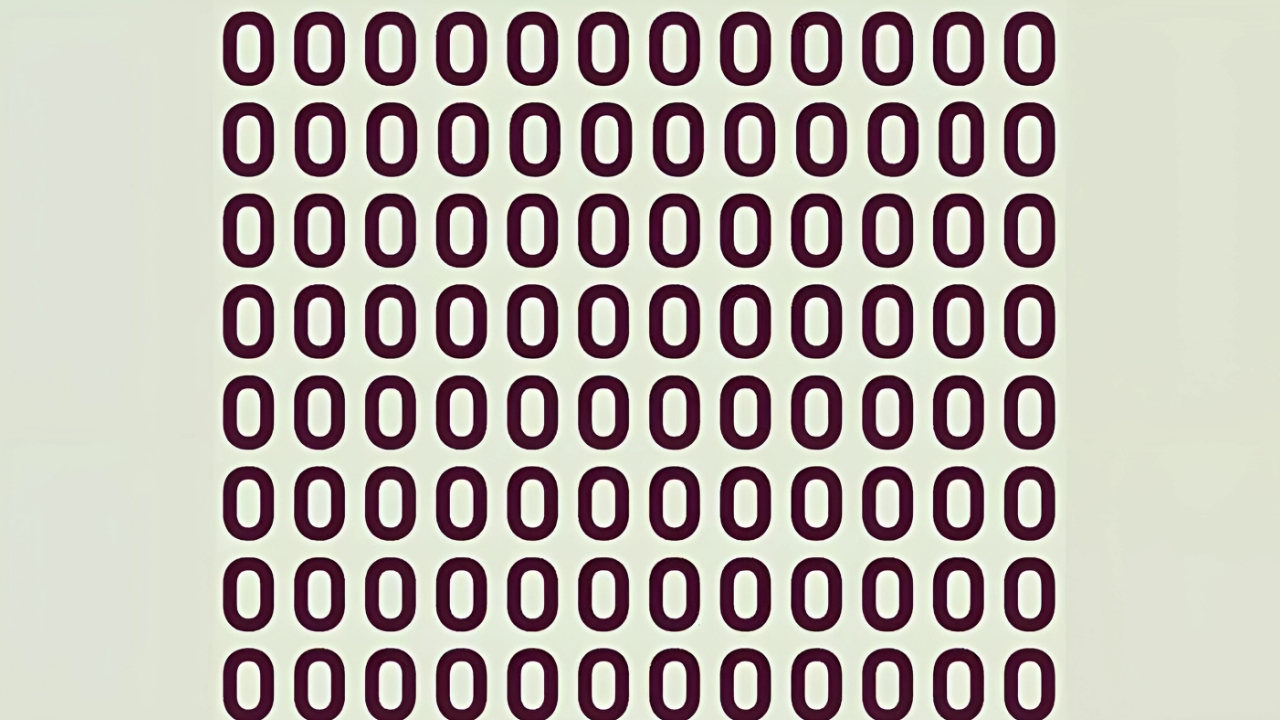Find the Hidden Digit : Optical illusions have fascinated people for centuries, blending art, psychology, and science to create mind-bending experiences. These visual puzzles challenge our perception, forcing our brains to question what our eyes see. Among the most engaging types of optical illusions are those that hide objects, numbers, or shapes within a seemingly chaotic or patterned image.
Today, we dare you to test your observation skills with an exciting challenge: find the hidden digit in just 7 seconds! This optical illusion is designed to push your visual acuity and cognitive speed to the limit. Ready to take on the challenge? Let’s dive into the world of optical illusions and explore why they captivate us, how they work, and how you can master this particular puzzle.
What Are Optical Illusions?

Optical illusions are images or patterns that deceive our eyes and brains, making us perceive something that differs from reality. They exploit the way our visual system processes information, often revealing the quirks and limitations of human perception. Our brains are wired to make quick judgments about what we see, filling in gaps or interpreting patterns based on past experiences. Optical illusions take advantage of these shortcuts, creating confusion between what is actually present and what our brain interprets.
There are several types of optical illusions, including:
-
Literal Illusions: These create images that are different from the objects that make them, like seeing a face in a cloud.
-
Physiological Illusions: These result from the overstimulation of the eyes or brain, often involving bright colors or repetitive patterns.
-
Cognitive Illusions: These rely on unconscious assumptions our brains make, such as misjudging the size of an object due to its surroundings.
The challenge of finding a hidden digit among letters falls into the category of cognitive illusions, specifically a hidden object illusion. It requires you to focus intensely and filter out distractions to spot the anomaly in the image.
Why Optical Illusions Are So Engaging
Optical illusions are more than just visual tricks; they’re mental workouts that captivate people of all ages. Here’s why they’re so appealing:
-
Brain Exercise: Optical illusions challenge your brain to think differently, improving focus, attention to detail, and problem-solving skills.
-
Fun and Competition: Timed challenges, like finding a hidden digit in 7 seconds, add an element of excitement and competition, whether you’re racing against yourself or others.
-
Universal Appeal: Illusions don’t require specialized knowledge, making them accessible to everyone, from kids to adults.
-
Insight into Perception: They reveal how our brains process visual information, offering a glimpse into the fascinating world of neuroscience and psychology.
This particular challenge—spotting a hidden digit among a sea of letters—tests your ability to discern subtle differences in a visually cluttered environment. It’s a perfect blend of fun and mental stimulation.
The Challenge: Spot the Hidden Digit in 7 Seconds
Imagine a grid filled with rows and rows of letters, all seemingly identical at first glance. Somewhere within this jumble lies a single digit, camouflaged to blend in with its surroundings. Your task is to find it in just 7 seconds. This optical illusion is designed to trick your brain, as the digit is cleverly disguised to look like part of the letter pattern. The time constraint adds pressure, forcing you to rely on quick observation and sharp focus.
To succeed, you’ll need to:
-
Scan Systematically: Instead of staring aimlessly, move your eyes across the image in a structured way, such as left to right or top to bottom.
-
Look for Anomalies: The digit will differ slightly from the letters, perhaps in shape, thickness, or alignment. Pay attention to anything that stands out.
-
Stay Calm Under Pressure: The 7-second timer can make you feel rushed, but staying focused will help you spot the digit faster.
Ready to try it? Set a timer for 7 seconds and see if you can beat the clock. If you don’t have the image handy, don’t worry—optical illusions like this are widely available online, and the techniques discussed here will help you tackle similar challenges.
Tips to Master Optical Illusions
If you’re struggling to find the hidden digit, don’t worry! Optical illusions are designed to be tricky, but with practice, you can improve your skills. Here are some strategies to help you succeed:
-
Train Your Eyes: Practice with other hidden object puzzles to get better at spotting subtle differences. The more you expose yourself to these challenges, the sharper your observation skills will become.
-
Adjust Your Focus: Sometimes, slightly defocusing your eyes or looking at the image from a different angle can make the hidden object pop out.
-
Break It Down: Divide the image into smaller sections and examine each one closely. This can make it easier to spot the digit without feeling overwhelmed by the whole image.
-
Practice Peripheral Vision: Sometimes, the hidden object becomes more noticeable when you’re not looking directly at it. Try glancing around the edges of the image.
-
Stay Patient: If you don’t spot the digit in 7 seconds, take a moment to reset and try again. Speed comes with experience.
The Science Behind the Illusion
Why is it so hard to spot the hidden digit? The answer lies in how our brains process visual information. When you look at an image filled with letters, your brain tries to group similar elements together, a phenomenon known as Gestalt grouping. This helps us make sense of complex scenes but can also make it harder to notice something that doesn’t fit the pattern, like a digit among letters.
Additionally, optical illusions often exploit figure-ground organization, where our brain struggles to separate the foreground (the digit) from the background (the letters). The digit is designed to blend in, with similar colors, shapes, or sizes, making it nearly invisible at first glance. The 7-second time limit adds another layer of difficulty by limiting the time your brain has to process the image and override its initial assumptions.
Studies in cognitive psychology suggest that people with strong attention to detail and quick visual processing skills tend to perform better at these tasks. However, anyone can improve with practice, as the brain is highly adaptable and can learn to spot patterns more effectively over time.
Why Time Limits Matter
The 7-second time limit isn’t just there to make the challenge more exciting—it also taps into how our brains function under pressure. When you’re racing against the clock, your brain prioritizes speed over accuracy, which can lead to missing subtle details. This is why optical illusions with time constraints are so effective at testing both your perception and your ability to stay calm under stress.
If you don’t find the digit in 7 seconds, don’t be discouraged. The time limit is meant to push you to your limits, but even taking a bit longer means you’re still engaging your brain in a meaningful way. Each attempt helps you refine your skills and trains your brain to process visual information more efficiently.
Benefits of Optical Illusion Challenges
Engaging in optical illusion challenges like this one offers more than just entertainment. Here are some benefits:
-
Improved Focus: Regularly tackling visual puzzles sharpens your ability to concentrate on fine details.
-
Enhanced Cognitive Skills: Optical illusions stimulate critical thinking and problem-solving, which can translate to other areas of life.
-
Stress Relief: While the time limit adds excitement, the act of focusing on a puzzle can be a relaxing break from daily stress.
-
Fun for All Ages: These challenges are a great way to bond with friends or family, turning them into a friendly competition.
How to Find More Optical Illusions
If you enjoyed this challenge, there are countless other optical illusions to explore. Websites like Jagran Josh, Puzzle Prime, and Bright Side regularly publish new puzzles, ranging from hidden objects to impossible shapes and color-based illusions. You can also find mobile apps dedicated to brain teasers and optical illusions, offering a convenient way to practice on the go.
For this specific challenge, search for “hidden digit optical illusion” online to find similar images. Many websites provide interactive versions where you can test your skills and even reveal the answer if you get stuck. Social media platforms like X are also great places to discover new illusions shared by puzzle enthusiasts.
Optical Illusions Answer

Take the Challenge Again!
Now that you know the tricks and science behind optical illusions, why not give the challenge another try? Grab an image with a hidden digit, set your timer for 7 seconds, and see if you can beat your previous attempt. Share the challenge with friends or family to see who can spot the digit fastest. The more you practice, the better you’ll get at unraveling these visual mysteries.
Optical illusions remind us that our perception of the world isn’t always as straightforward as it seems. They’re a fun, engaging way to explore the complexities of the human brain while sharpening your skills. So, did you find the hidden digit? If not, keep practicing—you’ll get it next time!
